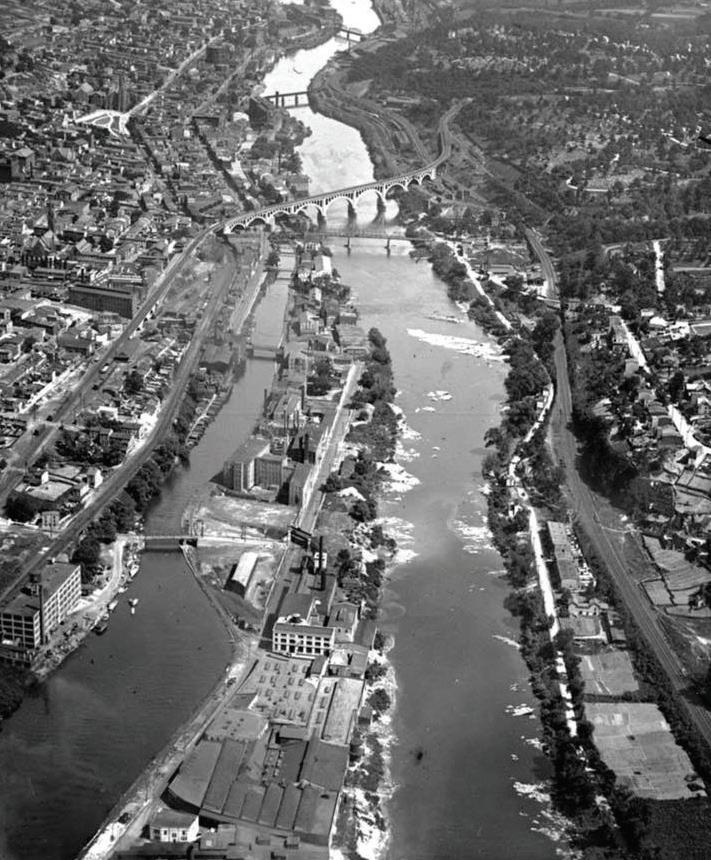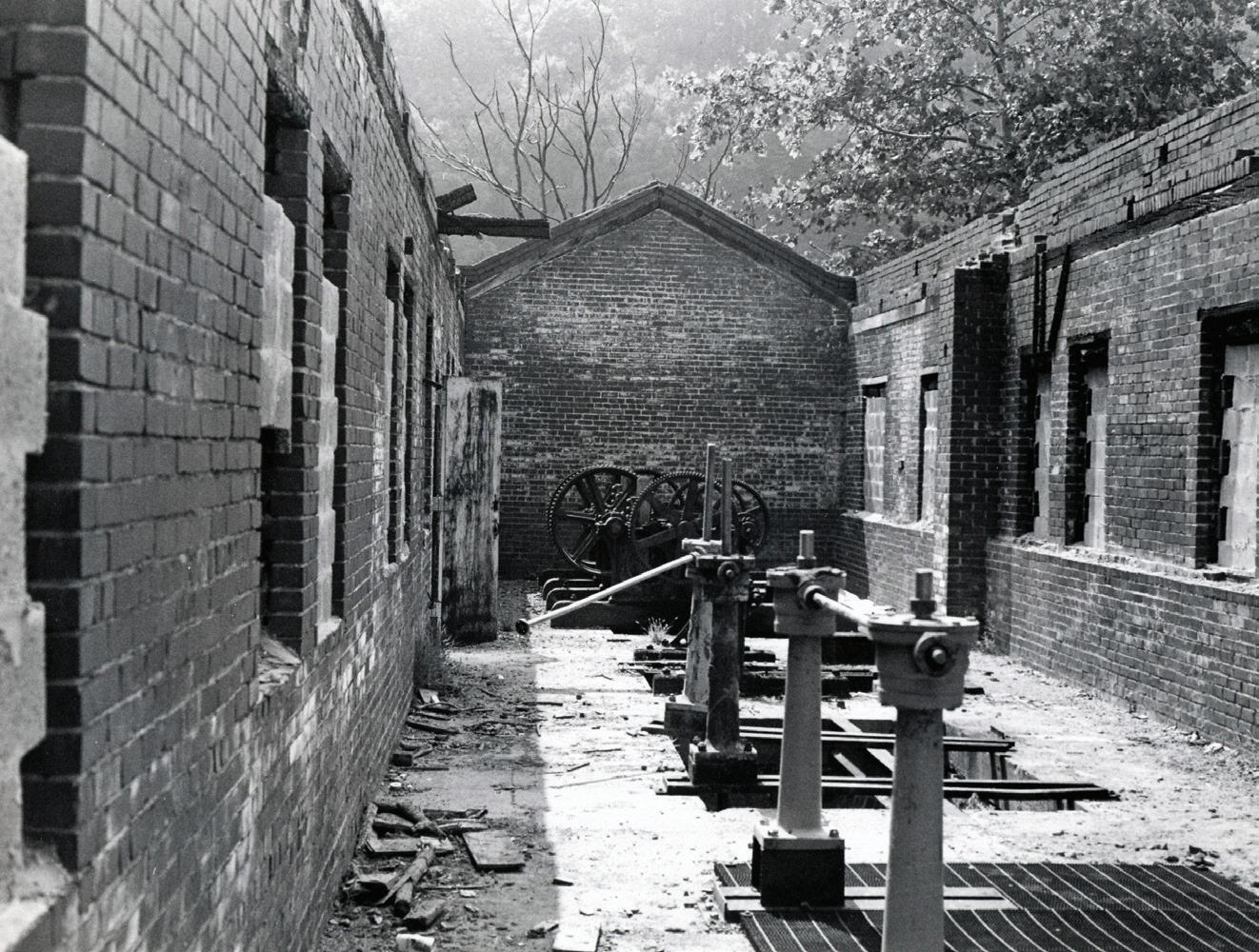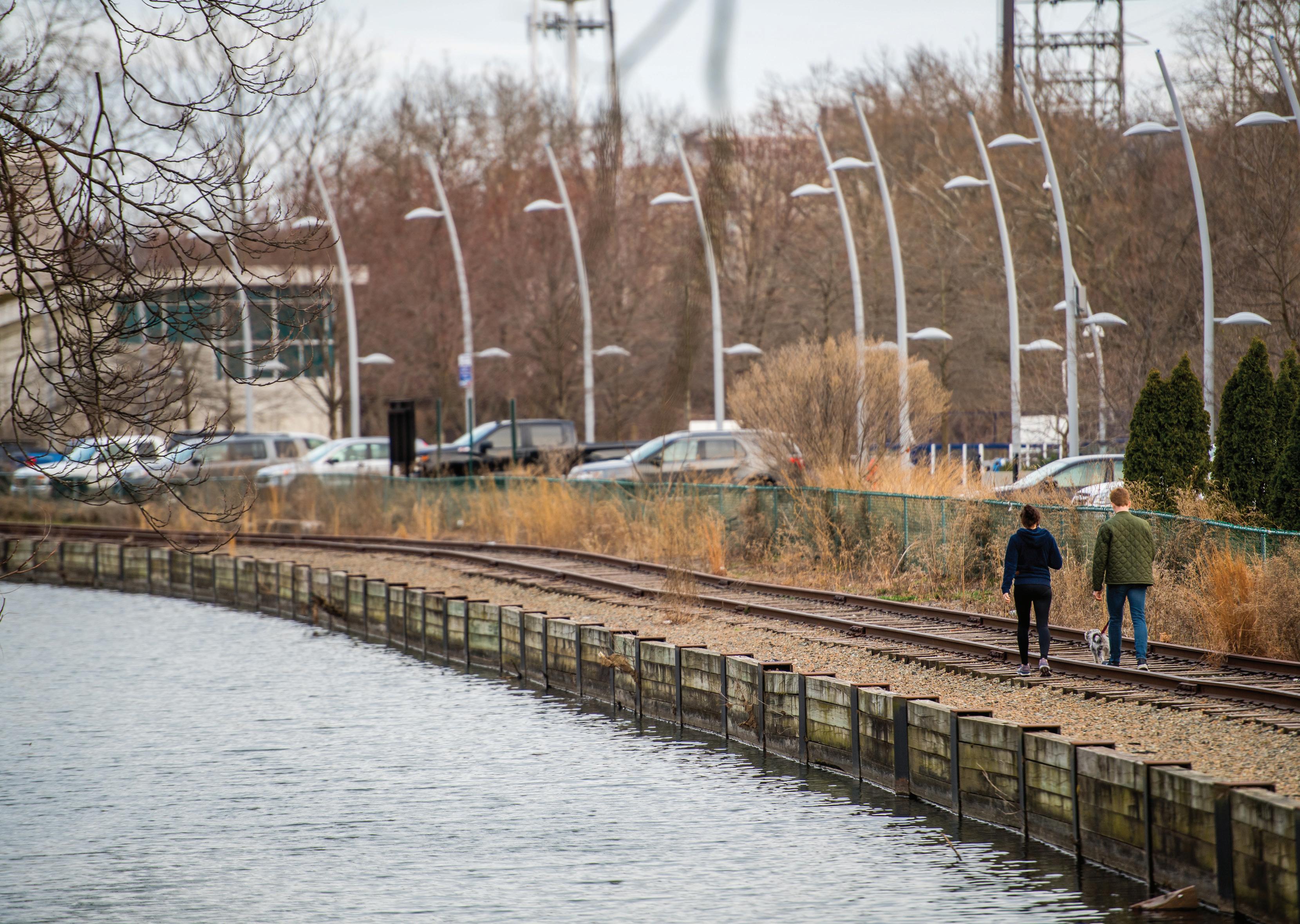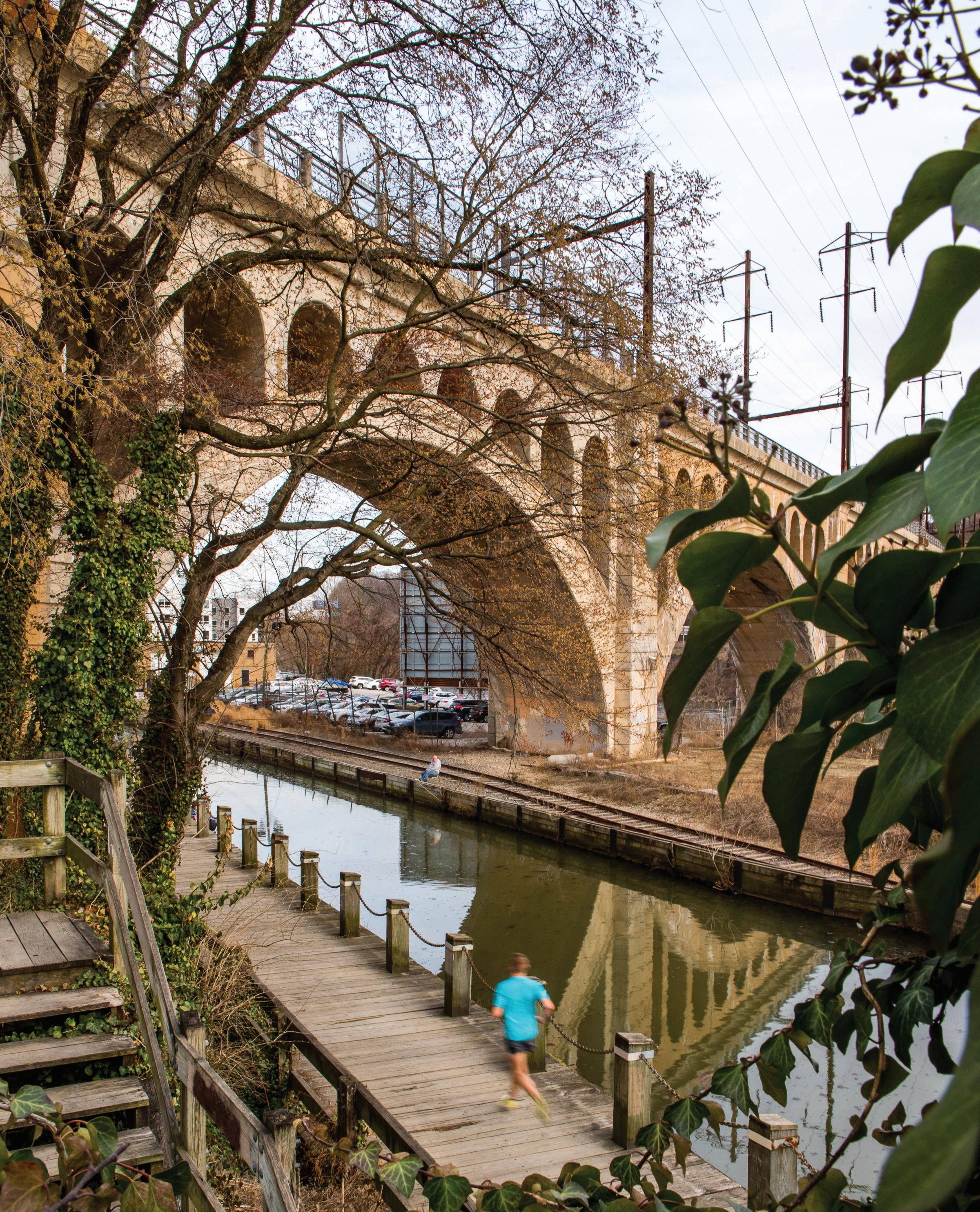
13 minute read
Cover Profile
Tales From the Towpath
Manayunk’s signature trail takes its tourists on a trip through time.

By Leo Dillinger Photography by JPG Photo & Video (jpgphotography.com) and courtesy of Kay Sykora
Over the last year, neighborhood residents and visitors have found solace along the Manayunk Canal and Towpath as a vital source of recreation and escapism. It is a scenic oasis for runners, walkers, and bikers with its vast array of green space. It’s a fountain of inspiration for artists and creative minds with its variety of murals and artwork. And it’s a trip through time for history buffs, where remnants of our nation’s industrial past still stand embedded within a natural landscape. The Manayunk Canal and Towpath has become a defining feature that makes this neighborhood such a unique destination in the Greater Philadelphia area.
What many visitors to the trail may not realize is the rich history that surrounds them as they trek along this two-and-a-half mile stretch of the Schuylkill River Trail. If you take a look back into the neighborhood’s past, you’ll find that the story of the canal and towpath is truly the story of Manayunk’s rise to prominence.
EARLY HISTORY
In 1815, the Commonwealth of Pennsylvania chartered the Schuylkill Navigation Company to create a 108-mile long waterway that would link the coal-rich areas of Schuylkill County to the emerging commercial center of Philadelphia. Because the roads and early infrastructure of the United States were in such poor conditions at the time, industry took to the waterways to not only transport goods and supplies, but to utilize waterpower as an additional source of energy for mills and factories.
By 1818, the Manayunk segment of the canal was finished, but the entire system didn’t become fully operational until 1825 when the first boat of coal ventured down the waterway. This innovative system of canals, locks, channels, and dams that could drop boats as much as 25 feet spurred economic development for the entire region. As a result, Manayunk became known as “The Manchester of America” for its reputation as an industrial powerhouse of textiles and other products.
Sandy Sorlien, an Environmental Photographer and Educator at the Fairmount Water Works, has spent the last eight years studying the entire Schuylkill Navigation System and photographing the ruins of what is left for her upcoming book, “Inland: The Abandoned Canals of the Schuylkill Navigation,” which is set to be released in 2022.
“This was a very transformative project and it completely changed the way the river looked, even the course of it to some extent,” Sandy said. “It changed the whole ecology of the Schuylkill River Valley. It drew industry to wherever there were canals and locks because not only could there be commerce between the various communities, but there was also a water power aspect so that mills could use the canals as a way to run their water wheels. Basically, the Industrial Revolution was supercharged by the navigation of the canals. Where there weren’t any communities, suddenly everyone wanted to be near a canal. And Manayunk was one of those. It was actually laid out by the Schuylkill Navigation Company as the community of ‘Flat Rock’ at the beginning.”
As the presence of mills and factories grew along both embankments of the canal, so did the population of Manayunk. From the 1820s to the 1860s, the town’s landscape drastically changed from an area of farms and meadows to a manufacturing center at the base of a hillside surrounded by housing for immigrant millworkers and their families.
“Manayunk is here because of the canal,” Sandy said. “Some communities like Reading were already gridded and there before this project grew. But I would say the canal is Manayunk’s reason for being.”

The Schuylkill Navigation Company practically monopolized the region’s transportation industry up until 1842, when the Reading Railroad Company and other railroad lines established themselves as a more suitable alternative to the waterways. Upon completion of these rail lines, local industries soon realized trains were better equipped for the elements all year long, whereas the canal became susceptible to freezing temperatures in the winter, droughts in the summer, and immense flooding during heavy rains.
“Immediately competition started,” Sandy said. “The canal company had to start lowering its tolls to compete with the railroads. It was gradual but before that, they were able to realize greater profits.”
The canal’s role as a nexus for commerce began to fade by the end of the 19th century. Continuous seasons of floods and drought ravaged the system’s infrastructure, leaving the Schuylkill Navigation Company with major profit losses and very few options to endure the technological advancement of the times. The last barge of coal eventually made its way down the navigation system in 1917 and the last commercial traffic just a few years afterward, officially marking the end of an era. Outside of its limited use for waterpower to the remaining mills and factories in the area, the Manayunk Canal remained largely neglected for the next 60 years, ultimately transforming it into an industrial wasteland.
REVITALIZATION
In 1945, the Commonwealth of Pennsylvania had taken ownership of segmented properties along the Schuylkill Navigation to begin the groundbreaking “Schuylkill River Desilting Project.” As one of the first government-sponsored environmental cleanups in the United States, this project’s end goal was to clear the river of more than a century of coal waste and industrial pollution. The longterm impact of this project allowed wildlife and greenery to flourish along the banks of the Schuylkill River once again.
Despite its success and overall positive intentions, the desilting project resulted in the obliteration of numerous dams and locks, effectively erasing the entire history of the Schuylkill Navigation Company in many communities. Fortunately, the Commonwealth salvaged the two-mile section of canal in Manayunk.
By 1969, a longstanding debate had ensued to determine the fate of this once prized community asset. Some suggested an expressway be built on top of the canal to bypass Main Street while others considered the notion of paving it over to become a parking lot.
For Manayunk resident and longtime advocate of the canal, Harry Olson, this local landmark held much higher potential. As he sought to initiate a renewed interest in the canal area, Harry’s vision of Manayunk as a central connection for bicycling between Center City and Valley Forge began to materialize.
With funding secured from Mayor Frank Rizzo’s administration, work officially commenced to revive the canal and establish a new bike path from Lock Street to Shawmont Station fixated between the canal and properties that lined Main Street. By 1978, the City of Philadelphia officially took ownership from the Commonwealth of Pennsylvania and the inception of a new “Manayunk Towpath” had been established. (The historic Schuylkill Navigation mule towpath was actually on the river side, which was taken over by the rail line serving Venice Island industries).
By that time, other Manayunk residents, like Kay Sykora, began to share this vision of a thriving neighborhood that once again utilized the canal area as its primary catalyst for economic development.
“The thing that started becoming apparent was how valuable the trail and recreational system was,” Kay said. “I had been to Europe off and on and had seen

their biking, which is amazing. I could never understand why this country was so slow to that ballgame.”
On March 18, 1983, Manayunk’s Main Street District was officially listed in the National Register of Historic Places, citing the neighborhood’s vital role in the Industrial Revolution. In that same year, Kay and other neighborhood stakeholders initiated the first strategic planning for Manayunk. The plan contained conceptual renderings of what the future of the Manayunk Canal and Towpath area could look like. The exciting possibilities for the neighborhood paved the way for more financial investment into the community and by the end of the 1980s, a wave of retail shops and restaurants had blossomed in the vacant properties where manufacturing businesses once stood.
Manayunk had finally become a thriving commercial corridor in the 1990s. As a frequent visitor to the neighborhood, Mayor Ed Rendell became another essential advocate for Manayunk. By the end of his administration, he had allocated an estimated $9 Million in funds to redevelop Main Street’s streetscape and another $6 Million to expand the work along the canal and towpath area.
“We were lucky because we had people pushing this work forward,” Kay said. “What you didn’t see back then were small districts managed like Manayunk. We were probably the first small district in Philadelphia to create staffing and eventually put a BID [Business Improvement District] in place. Now the whole city does that. Because we were the only ones with people in place advocating for and positioning projects, we got funding. There was nobody competing with us.”
From that point onward, the partnership between the newly formed Manayunk Development Corporation and the City of Philadelphia consistently built upon the idea of the towpath and canal area as the cornerstone to the financial success of the Manayunk commercial corridor. According to Kay, the towpath has been redeveloped about four different times since it was first installed in 1978, with the most recent time being the addition of pedestrian lighting along the trail. The towpath’s revitalization process has seen the installation of several murals and art pieces, new plantings and greenery, and a number of other capital improvement projects stemming from the work along the trail including the Cotton Street Bridge, Venice Island Performing Arts and Recreation Center, and the iconic Manayunk Bridge Trail.




“One thing that I think helps with the message of the canal and towpath is that’s why people live here now. That didn’t used to be the case,” Kay said. “People lived here for jobs. But now, you have all these families moving in because of green space and it’s a safe neighborhood. That adds huge value in terms of feeding back onto Main Street and I think people are seeing the correlation between them now and the value these trails bring in enticing people to choose to live here. I’ve always realized that and it mystified me that other people didn’t at the time.”
The Towpath: Today and Tomorrow
As you travel along the Manayunk Canal and Towpath today, it’s hard not to recognize how much time, energy, and funding has been invested into the beautification of this community asset over the last 40 years. Despite all the progress made thus far, plenty of work remains to be done.
Beginning this year, The Manayunk Towpath will see the start of a $600,000 project that aims to implement a 2015 design plan that addresses the trail section at the heart of Main Street’s business district. Beautification efforts will take place along the canal “boardwalk” area between Cotton Street and Canal View Park, where building facades will be renovated and “opened” to improve the trail’s connections to Main Street businesses. This area will also see the addition of amenities like new landscaping, banners, and comfort stations.
Another significant project for the Manayunk Canal can be found further up the trail, where the Philadelphia Water Department aims to repair the Flat Rock Dam and revitalize Lock #68 and the sluice house. With the completion of this project, the canal will finally see river waters flowing into it for the first time in half a century. This fresh water at the top of the canal will not only improve its ecology, it will contribute to healthier source water at the city’s Queen Lane drinking water intake. The project will also create a slight current that has many community stakeholders considering the possibility of kayaks and other watercrafts floating down the canal in the foreseeable future.
Rob Armstrong, the Program Manager for the City of Philadelphia’s Office of Transportation, Infrastructure, and Sustainability (OTIS), is currently leading two additional capital improvement projects for the area. The first one is the long-awaited installation of pedestrian lighting atop the Manayunk Bridge. Once complete, this project will allow the bridge trail to remain open for its users 24/7 and improve its role as a link to Montgomery County for recreation and commuting purposes.
Rob is also managing a crucial preservation project at the lower locks of the canal (Lock #69 & #70) at Lock Street near the southern tip of Venice Island. The City of Philadelphia has secured a grant from Pennsylvania’s Department of Transportation (PENNDOT) and the design phase is underway to rehabilitate the masonry wall bordering the inactive Norfolk Southern railroad line.
“These funds are not typically spent on preservation projects, but the importance of that canal to Manayunk, the city, and the region is so significant that we received a transportation grant to do the project,” Rob said. “If the city, which owns the resource, did not address the wall and the wall were to collapse, the lower locks would collapse due to the weight of the wall and potentially puncture the clay lining of the canal, causing it to drain and there would be no more water in the canal.”
The Manayunk Canal & Towpath is a neighborhood feature that can’t be replicated or found anywhere else. Sure, you can find other canal systems across this country that are intact (and in some cases even functional). However, Manayunk is the only canal in the entire Schuylkill Navigation that has intact lock chambers on both ends. This neighborhood’s portion of the Schuylkill River Trail offers its residents and visitors a unique experience. For some, it’s a way to escape from the bustle of city life.
“Main Street is very busy from a traffic standpoint,” Rob Armstrong said. “Whenever I drive down or walk down, there are still a whole lot of people using the streetscape and going to the restaurants and what not. What’s really interesting to me is that the Towpath is the only place where you can be in a busy,

vibrant urban environment with a lot of retail and restaurants and all you have to do is walk a few feet to be in a whole different landscape.”
For others, the last vestiges of an industrial past surrounded in a natural setting evoke a sense of wonder and otherworldliness.
“They are just wonderful ruins,” Sandy said. “Some of them are quite intact while others are mysteriously buried and you can only see the tops of them. Some of these places can still spark your imagination and care about the history of how economies change.”
Manayunk became the neighborhood it is today thanks to the canal and towpath. From the early years as a rising industrial hotspot to the trailblazing revitalization efforts over the last 40 years, it’s impossible to ignore the correlation between activity along the canal and the commercial success of the Manayunk business district.
If not for the constant investment of time, energy, and funding from government agencies, community partners, and a myriad of local advocates, volunteers, and stakeholders, we might very well be telling an entirely different story of Manayunk.
“I’ve always thought it was an interesting story that the economics of Manayunk have always rested on the canal from the early days in one identity to today moving into another identity,” Kay said. “I think there are a wealth of choices that you have here when you talk about the wildlife and green space all within an urban area.”











